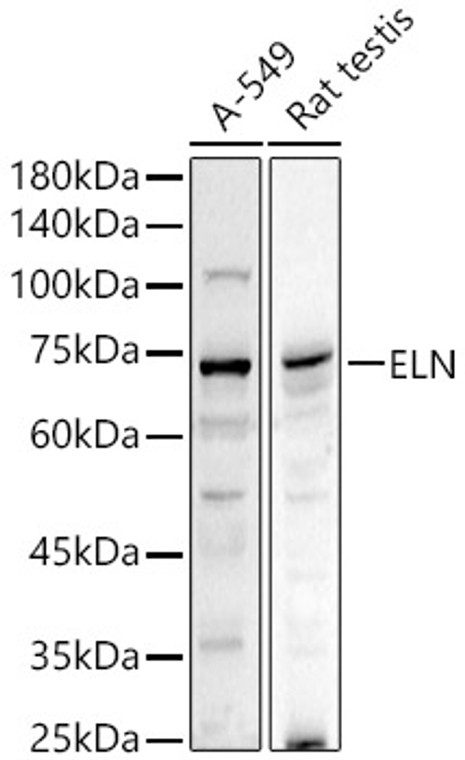| Host: |
Rabbit |
| Applications: |
WB/IF |
| Reactivity: |
Human/Mouse/Rat |
| Note: |
STRICTLY FOR FURTHER SCIENTIFIC RESEARCH USE ONLY (RUO). MUST NOT TO BE USED IN DIAGNOSTIC OR THERAPEUTIC APPLICATIONS. |
| Short Description: |
Rabbit polyclonal antibody anti-ELN (27-200) is suitable for use in Western Blot and Immunofluorescence research applications. |
| Clonality: |
Polyclonal |
| Conjugation: |
Unconjugated |
| Isotype: |
IgG |
| Formulation: |
PBS with 0.02% Sodium Azide, 50% Glycerol, pH7.3. |
| Purification: |
Affinity purification |
| Dilution Range: |
WB 1:500-1:1000IF/ICC 1:50-1:200 |
| Storage Instruction: |
Store at-20°C for up to 1 year from the date of receipt, and avoid repeat freeze-thaw cycles. |
| Gene Symbol: |
ELN |
| Gene ID: |
2006 |
| Uniprot ID: |
ELN_HUMAN |
| Immunogen Region: |
27-200 |
| Immunogen: |
Recombinant fusion protein containing a sequence corresponding to amino acids 27-200 of human ELN (NP_001265868.1). |
| Immunogen Sequence: |
GGVPGAIPGGVPGGVFYPGA GLGALGGGALGPGGKPLKPV PGGLAGAGLGAGLGAFPAVT FPGALVPGGVADAAAAYKAA KAGAGLGGVPGVGGLGVSAG AVVPQPGAGVKPGKVPGVGL PGVYPGGVLPGARFPGVGVL PGVPTGAGVKPKAPGVGGAF AGIPGVGPFGGPQP |
| Tissue Specificity | Expressed within the outer myometrial smooth muscle and throughout the arteriolar tree of uterus (at protein level). Also expressed in the large arteries, lung and skin. |
| Post Translational Modifications | Elastin is formed through the cross-linking of its soluble precursor tropoelastin. Cross-linking is initiated through the action of lysyl oxidase on exposed lysines to form allysine. Subsequent spontaneous condensation reactions with other allysine or unmodified lysine residues result in various bi-, tri-, and tetrafunctional cross-links. The most abundant cross-links in mature elastin fibers are lysinonorleucine, allysine aldol, desmosine, and isodesmosine. Hydroxylation on proline residues within the sequence motif, GXPG, is most likely 4-hydroxy as this fits the requirement for 4-hydroxylation in vertebrates. |
| Function | Major structural protein of tissues such as aorta and nuchal ligament, which must expand rapidly and recover completely. Molecular determinant of the late arterial morphogenesis, stabilizing arterial structure by regulating proliferation and organization of vascular smooth muscle. |
| Protein Name | ElastinTropoelastin |
| Database Links | Reactome: R-HSA-1474228Reactome: R-HSA-1566948Reactome: R-HSA-2129379 |
| Cellular Localisation | SecretedExtracellular SpaceExtracellular MatrixExtracellular Matrix Of Elastic Fibers |
| Alternative Antibody Names | Anti-Elastin antibodyAnti-Tropoelastin antibodyAnti-ELN antibody |
Information sourced from Uniprot.org
12 months for antibodies. 6 months for ELISA Kits. Please see website T&Cs for further guidance







